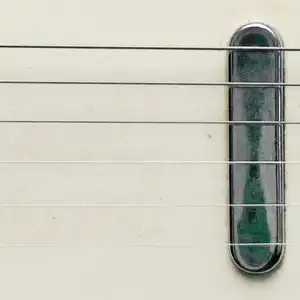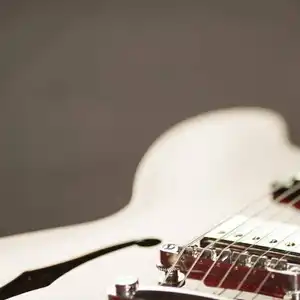What Was the Lawsuit Era of Guitars?


If you’ve spent some time browsing Reverb or Facebook Marketplace for used guitars, you’ve probably heard of lawsuit era guitars. These guitars look like classic guitars such as Gibson Les Pauls or Fender Stratocasters, except they aren’t. Instead, they are most often Japanese copies of those guitars made to varying degrees of quality.
Many people love their lawsuit guitars. Though they may not be the real deal, these guitars can look and sound great. In years past, they could be purchased for cheap too. In recent years however, these guitars have become popular as unique, vintage guitars that are an important part of guitar history. Many sell for well over $1,000 these days due to the demand.
But what’s the real story behind the infamous lawsuit era guitars? How did they come about? Are they really as good as some people claim? In today’s article, we’re going to take a closer look at the lawsuit era and unravel some of the mystique surrounding these guitars.
Before the Flood
Before we can get to the lawsuit era, let’s quickly look at the state of the guitar world prior to their introduction.
The electric guitar quickly rose to prominence in the 50s alongside rock and roll. With this new form of music centered around the electric guitar, the guitar skyrocketed in popularity. Young people in particular were enamored with the electric guitar, and they wanted to get their hands on them.
As we know, Fender and Gibson quickly became the two main manufacturers and filled the demand for electric guitars. During the later 50s and 60s, guitar continued to get more and more popular. Demand kept growing, and Fender and Gibson kept pumping out guitars to meet it.
Things started to change a bit in the 70s though. As demand continued to grow, Fender and Gibson started to struggle. Prices started rising, and according to some, the quality of their guitars started to decline.
With higher prices and perceived lower quality, many potential customers were frustrated. Guitars were more expensive than ever, yet they didn’t seem to match up to the guitars of the 50s and 60s. Many couldn’t afford new guitars, and those who could weren’t exactly excited about spending lots of money on a guitar that didn't meet their expectations.
As you can probably guess, these conditions are what led to the demand for "lawsuit" guitars. If people thought the name brands were raising prices and lowering quality, why not just buy a similar quality knockoff for less money? And with that, we’re ready to talk about the lawsuit era guitars...

Imported Japanese Copies
Though the lawsuit era as we know it started in the 70s, the real story starts a little bit before that.
In 1954, a man named Harry Rosenbloom opened up a guitar shop in Bryn Mawr, Pennsylvania. He originally planned to sell American guitars such as Martin, but the wait times for new models was long. He simply could not keep up with the demand.
To deal with this, Rosenbloom decided to get into imports. He started importing Japanese guitars from the Hoshino Gakki company, founding a new company called Elger Guitars. You may not have heard about the Hoshino Gakki company, but you are definitely familiar with the brand they sold their guitars under—Ibanez.
By 1971, Hoshino Gakki bought out Elger guitars. First they went by Hoshino USA, but they quickly rebranded as Ibanez USA. Ibanez established themselves as a serious player in the budget guitar market, and many if not most of their earliest offerings looked suspiciously similar to guitars already offered by Gibson, Fender, and other companies. A quick look at their 1972 catalog is quite telling.
In the beginning, these guitars were often made of lower quality materials and didn’t match up to their American counterparts. Though they looked the part, they weren’t of the same quality. Woods, electronics, construction methods, and more were inferior to the American made models.
However, that wasn’t the case by the mid 70s. By then, companies like Ibanez and Takamine were making high quality guitars that didn’t just look similar; they played, felt, and sounded similar too. And in some cases, players felt that these guitars actually were better than the guitars they were based on.
As expected, these guitars became quite popular at the time. Considering the higher prices from the big manufacturers, why not get a Japanese copy that looks the same, is similar or even better in quality, and significantly more affordable?
That said, it couldn’t last forever. It was only a matter of time until Gibson, Fender, and the like decided to fight back against these companies copying their guitars and cutting into their sales.

Lawsuits and Legal Trouble
One of the most interesting things about the lawsuit era is that there weren't actually many lawsuits. You’d think that Fender and Gibson were filing suit every time a similar looking guitar hit the market, but that’s not the case. Lawsuits were actually fairly rare. That said, they did happen.
There’s one lawsuit in particular that really defined the name “lawsuit era.” Ibanez’s Super Standard Les Paul is arguably the most famous guitar of the lawsuit era, and it’s one of the only ones to actually cause a legal issue.
When looking at one, it’s incredibly obvious it’s supposed to be a Les Paul. They look nearly identical. From the binding and inlays to paint/finish colors and knobs, they were basically replicas save a couple small tweaks. However, there was one thing Gibson was particularly upset about—the headstock.
Gibson uses a very specific “open book” headstock design, which it started using as far back as 1902 and possibly earlier. That design is very closely tied to Gibson, and it’s something that the company is still very protective of to this day.
These Ibanez Super Standard Les Pauls (and most of their other Gibson-based models) used this headstock, and Gibson took issue with that. As a result, they decided to take Ibanez to court over it. Eventually, the two companies settled out of court.
There were a few other similar lawsuits, but this was by far the most famous of them. Even though Gibson and Fender weren’t overly litigious and filing suits over every guitar, the few suits that did happen and the potential threat of legal action was enough to put an end to the lawsuit era.

The Aftermath and Post-Lawsuit Era
Though the lawsuit era was over, companies like Ibanez and Takamine didn’t just pack up shop and stop making guitars. And even though Gibson had stopped companies from making cheaper copies of their guitars, the demand for more affordable guitars was still there. In this writer's opinion, the lawsuit era actually had a positive impact on the guitar industry at large.
To start, Gibson and Fender both would come out with their own line of budget guitars, being Epiphone and Squier respectively. Instead of letting other companies do it for them, they decided to make the cheaper versions of their own guitars themselves. Ibanez and others filling that space made them realize there was a market there, and now those companies continue to make affordable guitars alongside their higher end models.
As for the Japanese manufacturers like Ibanez, Takamine, and Greco, that’s a mixed bag. Some of them fizzled out all together, unable to produce non-copy guitars that could stand on their own in a competitive market. Others, like Greco, ended up getting bought out by larger companies. A few however were able to survive the transition.
Takamine for example is incredibly successful today. Though they started out making Martin copies, now they’re known for making world-class acoustics used by professional musicians all over the world. Takamine is a well respected brand in the acoustic guitar world, and they can go toe-to-toe with USA made Martins.
Ibanez is likely the most successful of them all, becoming one of the biggest guitar companies in the world. After the lawsuit era, Ibanez came up with numerous designs of their own that went on to be successful. The AR series, the Iceman, and the Destroyer were some of the first truly original designs from Ibanez, and they helped the company distance itself from its Gibson and Fender copies.
After the introduction of those models, Ibanez continued designing new guitars and creating their own designs. The RG series from the 80s and 90s for example is a now iconic guitar that is still made to this day. Though Ibanez may have started out with imitations, they now are their own company with their own designs that are highly respected in the guitar world.
The Lawsuit Era—A Catalyst for Change
The lawsuit era of guitars came about in the 70s for simple reasons; brand name guitars were getting more and more expensive, and quality was going down. So Japanese brands like Ibanez stepped in to meet the needs of consumers who didn’t want to pay high prices for low quality guitars. Though these guitars weren’t always of the same quality as those they were based on, they met the needs of guitarists and were a hit.
While many of these guitars went over the line legally speaking, the end result was ultimately positive for the guitar community. Gibson and Fender responded to the challenges of this era with positive changes in their own lines, increasing the quality of their USA instruments and creating Epiphone and Squier to provide budget options. And some of the copycat manufacturers like Ibanez and Takamine went on to become well respected companies in their own right.
Whether or not you own or are interested in lawsuit guitars, the lawsuit era was an important historical moment in the history of guitar manufacturing that changed the guitar industry forever.
Other Posts you may like

Guitar Strings Order: How the Guitar is Tuned and Why

Two Handed Tapping: Our Top 8 Tappers of All Time

Which Guitar Strings Wear Your Fret Wire Down More?

What is Nashville Tuning? Its History, Best Guitar Strings & Uses

Guitar Scale Length Explained: String Tension & Playability

What Guitar Strings I Used To Play...
0 Responses
Leave a Reply
Your email address will not be published. Required fields are marked *

